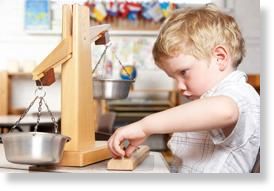
© MBI / AlamyChildren can design simple experiments to explore their world
Preschool children spontaneously invent experiments in their play, according to research published this month in
Cognition. The findings suggest that basic scientific principles help very young brains to learn about the world.
Psychologists have been drawing a comparison between cognitive development and science for years -- an idea referred to as 'the child as scientist'. But recently scientists have been trying to discover whether this is more than just a neat analogy.
In the latest study, researchers at the Massachusetts Institute of Technology (MIT) in Cambridge and Stanford University in California presented four- to five-year-old children with a specially designed toy that lit up and played music when the child placed certain beads on it.
In cases in which the children didn't know which beads made the toy play, the researchers found that the kids tested each possibility in turn in order to find out -- much like the way in which scientists devise their experiments to test individual variables separately. Laura Schulz, one of the researchers from MIT, explains that it's the same idea that you use when trying to find out which of your keys opens a door: "You might change the position of the key, you might change the key, but you're not going to change both at once," she says.
Schulz and her team found that children seem to perform these methodical experiments only when they are given ambiguous information. One group of children were shown that each of four differently marked beads all made the toy work. The others were shown that only two of the beads worked. The children were then given the beads as two pairs -- one fixed pair and one that could be snapped apart -- and were left to play.
The researchers wanted to see whether the children would try to snap the beads apart in order to test which bead in the combination made the toy work; what they found suggests that children make decisions on the basis of the potential for gaining new information.
The result marks a key step in the evolving field of cognitive development. Schulz feels that science is no longer simply an analogy for childhood development, but that this type of play is "a fundamental precursor" to science that is seen surprisingly early on. "In a sense, everyone is capable of inquiry and discovery in these ways," Schulz explains. "What scientists do is apply it to cognitive demands that are at the very edge of human knowledge."
The team was surprised by what the children did with the inseparable pair. The toy was designed to take the bead pairs horizontally, but the children tried to test each bead separately by holding the pair vertically. So the researchers conducted a second experiment, this time giving the children only the fixed set of beads and showing them that the toy worked when it was put on the toy horizontally. The fact that the children still tested both ends of the bead pair provides evidence of ingenuity that shares common principles with science, says Schulz.
Sara Baker, a researcher at the Bristol Cognitive Development Centre, University of Bristol, UK, says she hopes that this research will improve our understanding of the capabilities of preschoolers and that it could have implications for teaching methods. "I think it's fantastic work; this is a real step forward in that it is a scientific approach to what kids understand," says Baker.
ReferencesCook, C., Goodman, N. D. & Schulz, L. E. Cognition 120, 341-349 (2011); doi:10.1016/j.cognition.2011.03.003.
Reader Comments
to our Newsletter